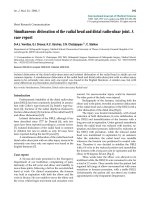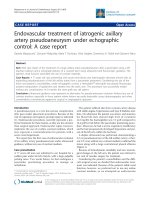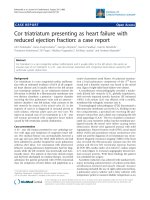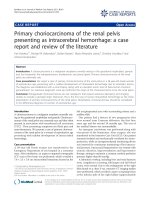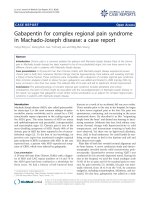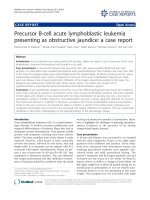Báo cáo y học: " Osteoid osteoma of the femoral head treated by radiofrequency ablation: a case report" ppt
Bạn đang xem bản rút gọn của tài liệu. Xem và tải ngay bản đầy đủ của tài liệu tại đây (1.56 MB, 4 trang )
CAS E REP O R T Open Access
Osteoid osteoma of the femoral head treated by
radiofrequency ablation: a case report
Koyeli M Mahata
1*
, Shyam KN Keshava
1
and Korula M Jacob
2
Abstract
Introduction: We present a case report highlighting the unusual location and atypical imaging characteristi cs of
an osteoid osteoma in the juxta-articular region of the femoral head, and treatment of the condition with
radiofrequency ablation. This treatment option is low in both risk and morbidity and is therefore the best option in
lesions that are difficult to access surgically because of the risks involved.
Case presentation: A 40-year-old Indian man from West Bengal presented to our facility with a history of
progressively severe left hip pain of insidious onset, requiring analgesics. Imaging with plain radiographs,
computed tomography and magnetic resonance imaging confirmed findings of osteoid osteoma in a subarticular
location in the femoral head, although imaging features were atypical due to the intra-articular subchondral
location.
Conclusion: Radiofrequency ablation is a newer treatment modality for osteoid osteoma that, being minimally
invasive, offers comparable results to surgery with a significantly lower morbidity. To the best of our knowledge,
treatment of osteoid osteoma in the foveal region of the femoral head with radiofrequency ablation has not been
reported to date. We wish to highlight the successful outcome in our index case using this technique.
Introduction
Osteoid osteomas represent 12% o f benign bone tumors
and were first described b y Jaffe in 1935 [1]. They are
twice as common in males; 90% occurring between 5
and 30 years of age [2]. In over 50% of cases they are
centered o n the cortex of the diaphysis of the femur or
tibia [1]. Within the femur, lesions are usually found
proximally, most commonly within the neck and inter-
trochanteric region [1]. It is kno wn that location of
osteoid osteomas in cancellous bone is rare and even
rarer in i ntra-capsular locations [2]. However the exact
incidence of juxta-articular osteoid osteomas in the
femoral head is not known. In most cases, affected indi-
viduals complain of severe pain related to the lesion
which is worse at night and relieved by ingestion of
non-steroidal anti-inflammatory agents [3].
Plain radiographs demonstrate the nidus in 85% of
cases. A total of 20% of cases may be intra-medullary
and have less reactive sclerosis [4]. When intra-
capsular in location, an osteoid osteoma may present
with clinical features that mimic inflammatory synovi-
tis and with atypical radiological findings such as lack
of both sclerosis and periosteal re action [5]. Magnetic
resonance imaging (MRI) is less sensitive than
computed tomography (CT) and allows detection of
marrow edema and associated soft tissue edema; a
nidus is identified in only 65% of cases with MRI. CT
scanning improves detection of the nidus to more
than 85% [6].
Surgery remains the standard treatment in cases
where histology of the lesionisindoubt,neurovascu-
lar structures are within 1.5 cm, or in cases with
repeated failure of any other minimally invasive abla-
tive technique or percutan eous resection [7]. Success-
ful surgical therapy occurs in 88% to 100% of cases.
Primary radiofrequency ablation in a case series of
over 200 patients has had a success rate of 76% to
100% [6]. In another series the primary and secondary
success rates of this technique were 87% and 83%,
respectively. Surgical resection and open curettage
show comparable success rates, but are associated
with higher complication rates [8].
* Correspondence:
1
Department of Radiodiagnosis, Christian Medical College and Hospital,
Vellore, Tamil Nadu, India
Full list of author information is available at the end of the article
Mahata et al. Journal of Medical Case Reports 2011, 5:115
/>JOURNAL OF MEDICAL
CASE REPORTS
© 2011 Mahata et al; licensee BioMed Central Ltd. This is an Open Access article distributed under the terms of the Creative Commons
Attribution License ( which permits unrestricted use, distribution, and reproduction in
any medium, provided the original work is properly cited.
Case presentation
A 40-year-old Indian man from West Bengal presented
to our facility with progressive left hip pain of insidious
onset for a duration of five years. The pain had wor-
sened in the six months prior to presentation, and was
continuous, dull and aching in nature and relieved with
analgesics. His clinical examination was unremarkable
except for mild tenderness over the left hip anterior
joint line. All hip movements were normal and pain
free.
Plain radiographs of the pelvis revealed a 15 ×
11 mm, well defined lytic lesion with a thin sclerotic
rim located in the subarticular portion of the left
femoral head. Figure 1 s hows a plain radiograph in
anteroposterior view showing a well defined lytic lesion
with a thin sclerotic rim located in the subarticular
portion of the left femoral head (white arrow). On
MRI, the lesion was hypointense on T1-weighted
imaging and hyperintense with a hypointense rim on
T2-weighted imaging. Figure 2 shows a T1-weighted
axial MRI showing a corresponding hypointense lesion
(white arrow). Figure 3 shows a T2-weighted coronal
image showing hyperintense focus with a hypointense
rim (black arrows). Figure 4 shows T2 fat-suppressed
images in coronal sections showing hyperintense focus
with a hypointense rim (black arrows). CT sections
confirmed the above findings and revealed a distinct
nidus measuring 11 × 10 mm. Figure 5 shows an axial
CT section, confirming a clearly defined lucent nidus
with surrounding sclerotic rim (white arrow). A radio-
nuclide bone scan (Figure 6) revealed a focal hot spot
at this site (black arrow).
Figure 1 Plain radiograph in anteroposterior view showing a
well defined lytic lesion with a thin sclerotic rim located in the
subarticular portion of the left femoral head (white arrow).
Figure 2 T1-weighted axial MRI showing a corresponding
hypointense lesion (white arrow).
Figure 3 T2-weighted coronal image showing hyperintense
focus with a hypointense rim (black arrows).
Figure 4 T2 fat-suppressed images in coronal sections showing
hyperintense focus with a hypointense rim (black arrows).
Mahata et al. Journal of Medical Case Reports 2011, 5:115
/>Page 2 of 4
Despite the uncharacteristic location, base d on the
imaging features a diagnosis of osteoid osteoma was
made. After informed consent was obtained it was
decided to perform a radiofrequency ablation. Under
general anesthesia the nidus was localized with 3 mm
CT sections and osseous a ccess was established with a
4.5 mm drill. Figure 7 shows an a xial CT section with
radiofrequency ablation (RFA) needle placed within the
drilled tract. After localization, the RFA needle (Star-
burst SDE, RITA Medical Solutions, Mountain View,
CA, USA) was introduced through the drilled canal and
tip placed in the nidus. Monopolar R FA was performed
ata90°Cforaperiodof5minutesat60W.Figure8
shows res idual air pockets post radiofrequency ablation.
The procedure was deemed successful as our patient
was pain free within 24 hours of the procedure and
remained so at follow-up. Figure 9 shows a plain
radiograph in anteroposterior view (white arro w) at
review 4 months post procedure. Figure 10 shows plain
radiograph frog leg lateral views (black arrow) showing
resolution of the lesion.
Conclusion
RFA is an excellent alternative to surgical excision in the
foveal region as it avoids the complications associated
with surgical exposure of the femoral head, including
injury to the capsular vessels and post-operative capsu-
lar laxity. It also avoids weakening of the femoral neck
by large diameter drilling for surgical access and chon-
dral or osteochondral damage from resection of the sub-
chondral lesion. Furthermore, in this location there
exists a potential risk of avascular necrosis owing to
close proximity of the foveal artery in the ligamentum
teres. The foveal artery is a branch of posterior division
of the obturator artery, which becomes important to
avoid avascular necrosis of the head of the femur when
Figure 5 Axial computed tomography section confirming a
clearly defined lucent nidus with surrounding sclerotic rim
(white arrow).
Figure 6 Radionuclide bone scan demonstrating corresponding
focal hot spot (black arrow).
Figure 7 Axial computed tomography section with
radiofrequency ablation (RFA) needle placed within the drilled
tract.
Figure 8 Residual air pockets post radiofrequency ablation.
Mahata et al. Journal of Medical Case Reports 2011, 5:115
/>Page 3 of 4
the blood supply from the medial and lateral circumflex
arteries are disrupted.
In summary, the unusual finding in this index case is
the relative absence of bone thickening, which could be
due to the intra-capsular location. RFA is a better
option than surgery in this location as it avoids injury to
the articular margin, prevents capsular injury and
reduces the risk of weakening the femoral neck. Injury
to the foveal artery with the p otential risk of avascular
necrosis must be kept in mind when the lesion is close
to the fovea of the femoral head.
Consent
Written informed consent was obtained from the patient
for publication of this case report and accompanying
images. A copy of the written consent is available for
review by the Editor-in-Chief of this journal.
Acknowledgements
We acknowledge Dr George Koshy.
Author details
1
Department of Radiodiagnosis, Christian Medical College and Hospital,
Vellore, Tamil Nadu, India.
2
Department of Orthopaedics Unit II, Christian
Medical College and Hospital, Vellore, Tamil Nadu, India.
Authors’ contributions
Image interpretation and RFA was performed by SKNK and KMM. KMM was
a major contributor to writing the manuscript. KMJ was the orthopedic
surgeon involved in acquiring osseous access with the drill. All authors read
and approved the final manuscript.
Competing interests
The authors declare that they have no competing interests.
Received: 7 September 2010 Accepted: 24 March 2011
Published: 24 March 2011
References
1. Unni KK, (Ed): Dahlin’s Bone Tumours: General Aspects and Data on 11,087
Cases Philadelphia, PA: Lippincott-Raven; 1996.
2. Vigorita VJ, Ghelman B, Mintz D: Bone tumours. In Orthopaedic Pathology.
Edited by: Vigorita VJ. Philadelphia, PA: Lippincott Williams 2007:339.
3. Barei DP, Moreau G, Scarborough MT, Neel MD: Percutaneous
radiofrequency ablation of osteoid osteoma. Clin Orthop 2000,
373:115-124.
4. Yildiz Y, Bayrakci K, Altay M, Saglik Y: Osteoid osteoma: the results of
surgical treatment. Int Orthop 2001, 25:119-122.
5. Schlesinger AE, Hernandez RJ: Intracapsular osteoid osteoma of the
proximal femur: findings on plain film and CT. AJR Am J Roentgenol 1990,
154:1241-1244.
6. Cantwell CP, Obyrne J, Eustace S: Current trends in treatment of osteoid
osteoma with an emphasis on radiofrequency ablation. Eur Radiol 2004,
14:607-617.
7. Papagelopoulos PJ, Mavrogenis AF, Kyriakopoulos CK, Benetos IS, Kelekis NL,
Andreou J, Soucacos PNJ: Radiofrequency ablation of intra-articular
osteoid osteoma of the hip. Int Med Res 2006, 34:537-544.
8. Bruners P, Penzkofer T, Günther RW, Mahnken A: Percutaneous
radiofrequency ablation of osteoid osteomas: technique and results [in
German]. Rofo 2009, 181:740-747.
doi:10.1186/1752-1947-5-115
Cite this article as: Mahata et al.: Osteoid osteoma of the femoral head
treated by radiofrequency ablation: a case report. Journal of Medical
Case Reports 2011 5:115.
Figure 10 Plain radiograph frog leg lateral views (black arrow)
showing resolution of the lesion.
Figure 9 Plain radiograph in anteroposterior view (white
arrow) at review four months post procedure.
Mahata et al. Journal of Medical Case Reports 2011, 5:115
/>Page 4 of 4

